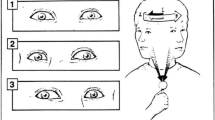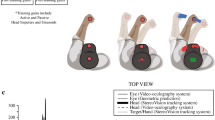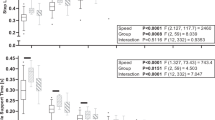Abstract
Individuals with bilateral vestibular hypofunction (BVH) often report symptoms of oscillopsia (the perception that the world is bouncing or unstable) during walking. Efference copy/proprioception contributes to locomotion gaze stability in animals, sometimes inhibiting the vestibulo-ocular reflex (VOR). Gaze stability requires both adequate eye velocity and appropriate timing of eye movements. It is unknown whether eye velocity (VOR gain), timing (phase), or both are impaired for individuals with BVH during walking. Identifying the specific mechanism of impaired gaze stability can better inform rehabilitation options. Gaze stability was measured for eight individuals with severe BVH and eight healthy age- and gender-matched controls while performing a gaze fixation task during treadmill walking. Frequency response functions (FRF) were calculated from pitch eye and head velocity. A one-way ANOVA was conducted to determine group differences for each frequency bin of the FRF. Pearson correlation coefficients were calculated to determine the relationship between the real and imaginary parts of the FRF and the Oscillopsia Visual Analog Scale (oVAS) scores. Individuals with BVH demonstrated significantly lower gains than healthy controls above 0.5 Hz, but their phase was ideally compensatory for frequencies below 3 Hz. Higher oVAS scores were correlated with lower gain. Individuals with BVH demonstrated ideal timing for vertical eye movements while walking despite slower than ideal eye velocity when compared to healthy controls. Rehabilitation interventions focusing on enhancing VOR gain during walking should be developed to take advantage of the intact timing reported here. Specifically, training VOR gain while walking may reduce oscillopsia severity and improve quality of life.


Similar content being viewed by others
References
Agrawal Y, Zuniga MG, Davalos-Bichara M et al (2012) Decline in semicircular canal and otolith function with age. Otol Neurotol 33:832–839
Agrawal Y, Bremova T, Kremmyda O, Strupp M (2013) Semicircular canal, saccular and utricular function in patients with bilateral vestibulopathy: analysis based on etiology. J Neurol 260:876–883
Agrawal Y, Schubert MC, Migliaccio AA et al (2014) Evaluation of quantitative head impulse testing using search coils versus video-oculography in older individuals. Otol Neurotol 35:283–288
Aickin M, Gensler H (1996) Adjusting for multiple testing when reporting research results: the Bonferroni vs Holm methods. Am J Public Health 86:726–728
Arshian MS, Hobson CE, Catanzaro MF et al (2014) Vestibular nucleus neurons respond to hindlimb movement in the decerebrate cat. J Neurophysiol 111:2423–2432. doi:10.1152/jn.00855.2013
Badaracco C, Labini FS, Meli A, Tufarelli D (2010) Oscillopsia in labyrinthine defective patients: comparison of objective and subjective measures. Am J Otolaryngol-Head Neck Med Surg 31:399–403. doi:10.1016/j.amjoto.2009.06.002
Bartl K, Lehnen N, Kohlbecher S, Schneider E (2009) Head impulse testing using video-oculography. Ann N Y Acad Sci 1164:331–333
Bendat J, Piersol A (2000) Random data: analysis and measurement procedures, 3rd edn. Wiley, New York
Bhansali SA, Stockwell CW, Bojrab DI (1993) Oscilopsia in patients with loss of vestibular function. Otolaryngol-Head Neck Surg 109:120–125
Brantberg K, Löfqvist L (2007) Preserved vestibular evoked myogenic potentials (VEMP) in some patients with walking-induced oscillopsia due to bilateral vestibulopathy. J Vestib Res 17:33–38
Chagnaud BP, Banchi R, Simmers J, Straka H (2015) Spinal corollary discharge modulates motion sensing during vertebrate locomotion. Nat Commun 6:7982. doi:10.1038/ncomms8982
Chim D, Lasker DM, Migliaccio AA (2013) Visual contribution to the high-frequency human angular vestibulo-ocular reflex. Exp Brain Res 230:127–135. doi:10.1007/s00221-013-3635-9
Combes D, Le Ray D, Lambert FM et al (2008) An intrinsic feed-forward mechanism for vertebrate gaze stabilization. Curr Biol 18:R241–R243. doi:10.1016/j.cub.2008.02.018
Crawford J (1964) Living without a balancing mechanism. Br J Ophthalmol 48:357–360
Della Santina CC, Cremer PD, Carey JP, Minor LB (2002) Comparison of head thrust test with head autorotation test reveals that the vestibulo-ocular reflex is enhanced during voluntary head movements. Arch Otolaryngol Head Neck Surg 128:1044–1054
Dickstein R, Laufer Y (2004) Light touch and center of mass stability during treadmill locomotion. Gait Posture 20:41–47
Dowiasch S, Marx S, Einhäuser W, Bremmer F (2015) Effects of aging on eye movements in the real world. Front Hum Neurosci 9:46. doi:10.3389/fnhum.2015.00046
Einhäuser W, Moeller GU, Schumann F et al (2009) Eye-head coordination during free exploration in human and cat. Ann N Y Acad Sci 1164:353–366. doi:10.1111/j.1749-6632.2008.03709.x
Fadaee SB, Migliaccio AA (2016) The effect of retinal image error update rate on human vestibulo-ocular reflex gain adaptation. Exp Brain Res 234:1085–1094. doi:10.1007/s00221-015-4535-y
Ferris FL, Kassoff A, Bresnick GH, Bailey I (1982) New visual acuity charts for clinical research. Am J Ophthalmol 94:91–96
Fetter M (2007) Vestibulo-ocular reflex. Dev Ophthalmol 40:35–51
Grossman GE, Leigh RJ (1990) Instability of gaze during walking in patients with deficient vestibular function. Ann Neurol 27:528–532
Grossman GE, Leigh RJ, Bruce EN et al (1989) Performance of the human vestibuloocular reflex during locomotion. J Neurophysiol 62:264–272
Grunfeld EA, Morland AB, Bronstein AM et al (2000) Adaptation to oscillopsia a psychophysical and questionnaire investigation. Brain 123:277–290
Guinand N, Pijnenburg M, Janssen M, Kingma H (2012) Visual acuity while walking and oscillopsia severity in healthy subjects and patients with unilateral and bilateral vestibular function loss. Arch Otolaryngol Head Neck Surg 138:301–306
Herdman SJ, Schubert MC, Tusa RJ (2001) Role of central preprogramming in dynamic visual acuity with vestibular loss. Arch Otolaryngol Head Neck Surg 127:1205–1210
Herdman SJ, Hall CD, Schubert MC et al (2007) Recovery of dynamic visual acuity in bilateral vestibular hypofunction. Arch Otolaryngol Head Neck Surg 133:383–389. doi:10.1001/archotol.133.4.383
Holm S (1979) A simple sequentially rejective multiple test procedure. Scand J Stat 6:65–70
Kiemel T, Elahi AJ, Jeka JJ (2008) Identification of the plant for upright stance in humans: multiple movement patterns from a single neural strategy. J Neurophysiol 100:3394–3406. doi:10.1152/jn.01272.2007
King OS, Seidman SH, Leigh RJ (1992) Control of head stability and gaze during locomotion in normal subjects and patients with deficient vestibular function. In: Berthoz A, Graf W, Vidal P-P (eds) The head-neck sensory motor system. Oxford University Press, New York, pp 568–570
Leigh RJ, Brandt T (1993) A reevaluation of the vestibulo-ocular reflex: new ideas of its purpose, properties, neural substrate, and disorders. Neurology 43:1288–1295
Lencer R, Trillenberg P (2008) Neurophysiology and neuroanatomy of smooth pursuit in humans. Brain Cogn 68:219–228. doi:10.1016/j.bandc.2008.08.013
Li C, Layman AJ, Carey JP, Agrawal Y (2015) Epidemiology of vestibular evoked myogenic potentials: data from the Baltimore Longitudinal Study of Aging. Clin Neurophysiol 126:2207–2215
Lucieer F, Vonk P, Guinand N et al (2016) Bilateral vestibular hypofunction: insights in etiologies, clinical subtypes, and diagnostics. Front Neurol 7:26. doi:10.3389/fneur.2016.00026
Mantokoudis G, Schubert MC, Tehrani ASS et al (2014) Early adaptation and compensation of clinical vestibular responses after unilateral vestibular deafferentation surgery. Otol Neurotol 35:148–154
Mantokoudis G, Saber Tehrani AS, Kattah JC et al (2015) Quantifying the vestibulo-ocular reflex with video-oculography: nature and frequency of artifacts. Audiol Neurotol 20:39–50. doi:10.1159/000362780
McCall AA, Moy JD, Puterbaugh SR et al (2013) Responses of vestibular nucleus neurons to inputs from the hindlimb are enhanced following a bilateral labyrinthectomy. J Appl Physiol 114:742–751
McGath JH, Barber HO, Stoyanoff S (1989) Bilateral vestibular loss and oscillopsia. J Otolaryngol 18:218–221
McGibbon CA, Palmer T, Goldvasser D, Krebs DE (2001) Kalman filter detection of blinks in video-oculography: applications for VVOR measurement during locomotion. J Neurosci Methods 106:171–178
Patla AE, Vickers JN (2003) How far ahead do we look when required to step on specific locations in the travel path during locomotion? Exp Brain Res 148:133–138. doi:10.1007/s00221-002-1246-y
Pozzo T, Berthoz A, Lefort L, Vitte E (1991) Head stabilization during various locomotor tasks in humans. II. Patients with bilateral peripheral vestibular deficits. Exp Brain Res 85:208–217
Sadeghi SG, Minor LB, Cullen KE (2012) Neural correlates of sensory substitution in vestibular pathways following complete vestibular loss. J Neurosci 32:14685–14695
Schneider E, Villgrattner T, Vockeroth J et al (2009) EyeSeeCam: an eye movement-driven head camera for the examination of natural visual exploration. Ann N Y Acad Sci 1164:461–467. doi:10.1111/j.1749-6632.2009.03858.x
Schubert MC, Zee DS (2010) Saccade and vestibular ocular motor adaptation. Restor Neurol Neurosci 28:9–18. doi:10.3233/RNN-2010-0523.Saccade
Schubert MC, Herdman SJ, Tusa RJ (2002) Vertical dynamic visual acuity in normal subjects and patients with vestibular hypofunction. Otol Neurotol 23:372–377
Schubert MC, Migliaccio AA, Della Santina CC (2006) Modification of compensatory saccades after aVOR gain recovery. J Vestib Res 16:285–291
Schubert MC, Della Santina CC, Shelhamer M (2008) Incremental angular vestibulo-ocular reflex adaptation to active head rotation. Exp Brain Res 191:435–446. doi:10.1007/s00221-008-1537-z
Shanidze N, Kim AH, Loewenstein S et al (2010) Eye-head coordination in the guinea pig II. Responses to self-generated (voluntary) head movements. Exp Brain Res 205:445–453. doi:10.1007/s00221-010-2375-3
Solomon D, Cohen B (1992) Stabilization of gaze during circular locomotion in darkness. II. Contribution of velocity storage to compensatory eye and head nystagmus in the running monkey. J Neurophysiol 67:1158–1170
Ward BK, Agrawal Y, Hoffman HJ et al (2013) Prevalence and impact of bilateral vestibular hypofunction: results from the 2008 US National Health Interview Survey. JAMA Otolaryngol Head Neck Surg 139:803–810
Wist ER, Brandt T, Krafczyk S (1983) Oscillopsia and retinal slip evidence supporting a clinical test. Brain 106:153–168
Acknowledgements
Thanks to Amy Bastian, PT, PhD, for sharing lab and equipment space for this study.
Author information
Authors and Affiliations
Corresponding author
Ethics declarations
Conflict of Interest
The authors declare that they have no conflicts of interest.
Source of Funding
This work was supported in part by PODS Scholarships from the Foundation for Physical Therapy, Inc. (E Anson, PI); a Wylie Dissertation Fellowship from the University of Maryland Graduate School (E Anson, PI); the University of Maryland’s Department of Kinesiology Graduate Student Research Initiative Fund (E Anson, PI); and National Institutes of Health grant R21 AG041714-01A1 (J Jeka, PI). For the remaining authors, none were declared.
Additional information
A version of this manuscript has been published in electronic form as a dissertation chapter in fulfillment of doctoral degree requirements under copyright by E Anson.
Rights and permissions
About this article
Cite this article
Anson, E.R., Kiemel, T., Carey, J.P. et al. Eye Movements Are Correctly Timed During Walking Despite Bilateral Vestibular Hypofunction. JARO 18, 591–600 (2017). https://doi.org/10.1007/s10162-017-0626-8
Received:
Accepted:
Published:
Issue Date:
DOI: https://doi.org/10.1007/s10162-017-0626-8




